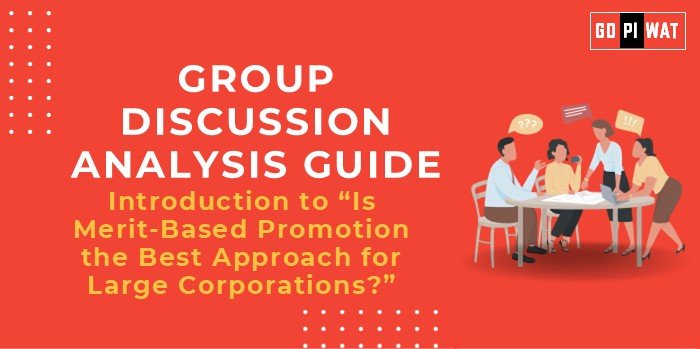📋 Group Discussion (GD) Analysis Guide
🌟 Introduction to “Is Merit-Based Promotion the Best Approach for Large Corporations?”
In a rapidly globalizing world where corporations drive economic growth and innovation, the topic of merit-based promotions sparks significant debate. Merit-based systems prioritize individual achievements, performance, and skills over tenure, seniority, or other subjective factors. This approach holds great appeal in fostering competitiveness and efficiency in large corporations, but it also raises concerns about fairness, workplace inclusivity, and employee morale.
📊 Quick Facts and Key Statistics
- Performance-Based Promotions: 79% of global companies consider performance reviews critical for promotions (McKinsey, 2023).
- Gender Disparity: Women represent only 28% of leadership positions globally, despite being equally qualified (UN Women, 2023).
- Bias in Promotion: 39% of employees perceive biases in workplace promotion systems (Harvard Business Review, 2022).
- Impact of Meritocracy: Firms with meritocratic systems show a 20% increase in productivity (Deloitte, 2023).
- Employee Satisfaction: 45% of employees prefer a mix of merit and tenure-based promotions for fairness (Gallup, 2022).
👥 Stakeholders and Their Roles
- Corporations: Design promotion systems to balance performance and equity while maintaining profitability.
- Employees: Seek transparent and fair opportunities for growth based on skill and contributions.
- Human Resource Departments: Implement unbiased promotion policies, conduct performance appraisals, and foster fairness.
- Governments/Regulators: Introduce laws ensuring non-discriminatory practices in promotions.
🏆 Achievements and Challenges
Achievements
- Increased Productivity: Merit-based systems motivate employees to excel, enhancing overall efficiency.
- Talent Recognition: Promotes high-performing individuals, fostering innovation and competitive work environments.
- Transparency: Well-executed systems ensure fairness and eliminate favoritism or biases.
- Attracting Top Talent: Meritocracies appeal to skilled professionals looking for performance-driven workplaces.
Challenges
- Risk of Bias: Subjectivity in measuring “merit” may reinforce unconscious biases and inequalities.
- Overlooked Team Efforts: Overemphasis on individual performance can undermine teamwork and collaboration.
- Employee Morale: Non-promoted employees may feel demotivated, leading to higher turnover rates.
🌍 Global Comparisons
- United States: Tech giants like Google adopt comprehensive performance-based systems but face challenges regarding diversity and inclusion.
- Japan: Seniority-based promotions remain dominant, but companies like Sony and Toyota increasingly shift towards hybrid systems.
📚 Case Studies
- Infosys: Integrates merit-based performance reviews with skills-based promotions, driving innovation and satisfaction.
- Unilever: Combines performance appraisals with diversity-focused initiatives, ensuring fair growth opportunities.
🗣️ Structured Arguments for Discussion
- Supporting Stance: “Merit-based promotions reward high-performing employees, enhancing competitiveness, productivity, and fostering a culture of excellence within large corporations.”
- Opposing Stance: “Overreliance on meritocracy can perpetuate biases, ignore team dynamics, and demotivate employees who feel overlooked, thus harming organizational morale.”
- Balanced Perspective: “While merit-based promotions drive performance, combining them with tenure and equity-focused initiatives ensures fairness, teamwork, and inclusive growth.”
💡 Effective Discussion Approaches
Opening Approaches
- Statistical Impact: “Firms with merit-based promotions report a 20% rise in productivity, yet 39% of employees still perceive biases in such systems.”
- Real-World Examples: “Companies like Infosys have achieved success by blending meritocracy with skill-focused promotions, ensuring fairness.”
Counter-Argument Handling
- “While merit-based systems can seem biased, implementing clear, transparent metrics and diversity frameworks can address concerns of inequity.”
🔍 Strategic Analysis of Strengths and Weaknesses
- Strengths: Improved performance, talent recognition, innovation.
- Weaknesses: Biases, demotivation of non-promoted staff.
- Opportunities: Hybrid promotion systems that blend merit, tenure, and diversity.
- Threats: Employee dissatisfaction, workplace conflicts, and turnover.
🎓 Connecting with B-School Applications
Real-World Applications
- Human Resource Management: Strategies for bias-free promotion frameworks.
- Leadership Development: Balancing individual performance with teamwork.
Sample Interview Questions
- “How can companies address biases in merit-based promotions?”
- “Are hybrid promotion systems more effective than pure meritocracy in large corporations?”
Insights for B-School Students
- Understand the importance of inclusive growth in leadership frameworks.
- Explore real-world challenges of balancing fairness and merit in promotions.


